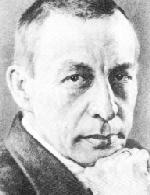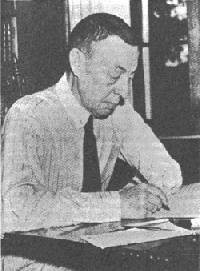

He studied at the Moscow Conservatory (1885-92) under Zverev (where Skryabin was a fellow pupil) and his cousin Ziloti for piano and Taneyev and Arensky for composition, graduating with distinction as both pianist and composer (the opera Aleko, given at the Bol'shoy in 1893, was his diploma piece). During the ensuing years he composed piano pieces (including his famous c-sharp Minor Prelude), songs and orchestral works, but the disastrous premiere in 1897 of his Symphony no.1, poorly conducted by Glazunov, brought about a creative despair that was not dispelled until he sought medical help in 1900: then he quickly composed his Second Piano Concerto. Meanwhile he had set out on a new career as a conductor, appearing in Moscow and London; he later was conductor at the Bol'shoy, 1904-6.
 By
this stage, and most particularly in the Piano Concerto no.2, the essentials
of his art had been assembled: the command of the emotional gesture conceived
as lyrical melody extended from small motifs, the concealrnent behind this
of subtleties in orchestration and structure, the broad sweep of his lines
and forms, the predominant melancholy and nostalgia, the loyalty to the
finer Russian Romanticism inherited from Tchaikovsky and his teachers.
These things were not to change, and during the remaining years to the
Revolution they provided him with the matenals for a sizable output of
operas, liturgical music, orchestral works, piano pieces and songs, even
though composition was generally restricted to periods of seclusion between
concert engagements. In 1909 he made his first American tour as a pianist,
for which he wrote the Piano Concerto no.3.
By
this stage, and most particularly in the Piano Concerto no.2, the essentials
of his art had been assembled: the command of the emotional gesture conceived
as lyrical melody extended from small motifs, the concealrnent behind this
of subtleties in orchestration and structure, the broad sweep of his lines
and forms, the predominant melancholy and nostalgia, the loyalty to the
finer Russian Romanticism inherited from Tchaikovsky and his teachers.
These things were not to change, and during the remaining years to the
Revolution they provided him with the matenals for a sizable output of
operas, liturgical music, orchestral works, piano pieces and songs, even
though composition was generally restricted to periods of seclusion between
concert engagements. In 1909 he made his first American tour as a pianist,
for which he wrote the Piano Concerto no.3.
Soon after the October Revolution he left Russia with his family for Scandinavia; in 1918 they arrived in New York, where he mainly lived thereafter, though he spent periods in Paris (where he founded a publishing firm), Dresden and Switzerland. There was a period of creative silence until 1926 when he wrote the Piano Concerto no.4, followed by only a handful of works over the next 15 years, even though all are on a large scale. During this period, however, he was active as a pianist on both sides of the Atlantic (though never again in Russia). As a pianist he was famous for his precision, rhythmic drive, legato and clarity of texture and for the broad design of his performances.